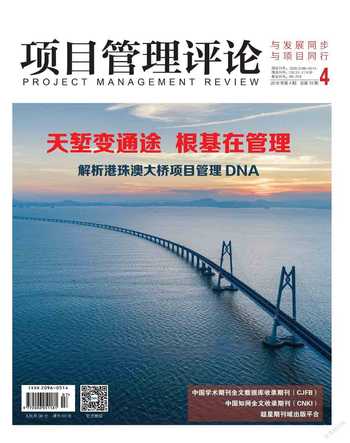斯特西·高夫:中国文化为项目管理注入活力
尉艳娟
他是項目管理界的赛车手。在他看来,项目管理与赛车可以并驾齐驱,互惠双赢。项目管理经验能够让他更好地备战比赛,而赛车的惊险刺激也加深了他对项目管理中“高效”一词的理解。
他是项目管理界的先行者。目前全球范围内关于项目管理的认证品种众多,他率先提出了评估项目管理认证有效性的三项标准(先决条件、覆盖面、评估的严格程度),并建立了“认证有效度立方体”模型。
他是项目管理界的开拓者。根据自己对行业的观察,他提出在PMI人才能力三角模型中,增加“产品能力(Product Talent)”。他还指出“高效项目团队的秘密武器是小型项目”。
他是项目管理界的耕耘者。20世纪70年代,他从业初期,项目管理采用“纯技术”的方法,如今,项目管理更加关注领导力、团队建设、相关方参与等软技能和商业环境、项目与战略的融合。他是这一过程的见证者和推动者。他还参与了数个项目管理专业组织的创立和项目管理标准的制定,曾担任IPMA副主席、IPMA美国分会主席等职。
他是中国文化爱好者。作为中国的常客,西安兵马俑这一宏伟的项目,曾让他对2 000多年前的项目从业者们肃然起敬。在担任“中国工程项目经理年度大奖”评委时,他曾被中国年轻人的卓越洞察力和项目智慧深深打动。在与中国专家的交流中,他着迷于《易经》、辩证法等中国思想对项目管理的影响。他倡导从中国文化中汲取项目管理智慧,而不仅仅是对西方理论采取“拿来主义”。
有人说,他是项目管理界的革命者,一直在不遗余力积极推动行业进步。有人说,他对项目管理的思考比任何人都深刻、全面、连贯。有人说,他是项目管理界的天才。
他就是斯特西·高夫(Stacy Goff)。
Interview
You were an amateur race car driver. Have you applied PM knowledge in driving race cars?
Stacy Goff: The experience of driving race cars and having a PM background is a two-way street—it offers benefits in both directions. First, I was successful as an amateur race driver because, in part, of my project management experience. I was always better-prepared than most other drivers; I was able to strategize, prioritize, and more intensely focus than others; it was easier to convince sponsors to support our effort; and we always attracted a strong team.
Second, as you suggest, racing improved my project insights: the excitement, risk and intensity of “driving at speed” gave me a much deeper understanding of the secrets of highperformance. And this was not just my own high-performance efforts, but also, those of my team.
In one of your articles, you have made comparisons about different PM certifications. Whats your attitude towards certifications (their role, necessity, etc.)?
Stacy Goff: Yes, the article you mentioned, Comparing PM Certifications: Which Is Best for You?, evaluates the top certifications in the world of project and program management. These range from exam-based certifications, to those that require professional assessment of demonstrated competences in actual initiatives. In the article, I identified three criteria for evaluating PM certifications: A. Prerequisites; B. Breadth of Coverage; C. Rigor of Assessment.
To write the article, I used independent research that evaluated a wide range of PM certification offerings, scoring each certification against the criteria above. I cross-multiplied the three criterias normalized scores to form what I named“The Certification Effectiveness Cube”. The key to each certifications appropriateness (and thus necessity) is whether it matches the role, and level of experience, of the certificant, and of the certification.
Each PM certification has a target audience, and a purpose for that audience. Some, such as those that use multiple-choice exams, are often designed for an entry-level audience: Those who are just beginning their career in project management. They do very little for more advanced practitioners.
Other certifications, with stronger prerequisites, higher breadth of coverage, and greater rigor, are targeted towards advanced audiences. These require more than memorizing for an exam; they require demonstrated competence or results in actual projects or programs.
Heres a caution: There is a significant difference between training to take a certification exam, and training or learning for project performance improvement. The former tends to focus on short-term memory retention (which expires, if unused, within two weeks), and how to take an exam. The latter tends to focus on how to manage a complex initiative to measurably increase business results through projects. Today, there appears to be more money spent around the world on the former, rather than on the latter. And then we wonder why so many projects fail!
We can draw project management wisdom from Chinas culture. As a frequent visitor to China, do you agree with it?
Stacy Goff: I totally agree. When I visit China, I combine speaking at major events, discussing in-depth project experiences with participants, together with touring. For an example of touring, one may read about the Terra-Cotta Warriors in Xian. But experiencing the magnificence of the site, and considering the massive project, first to build it, then to hide it, and now to reclaim it, gives new perspective and respect for the project engineers and artists of 2200 years ago.
I also served as a judge for the Chinese Construction Project Manager of the Year award. It was here that I reinforced my view about the exceptional insights and project management wisdom from these young (early 30s in age) experts in charge of USD billions of projects around the world.
In 2014, I spoke at an IPMA Research Conference in Tianjin. Immediately following my keynote speech, Professor Qi Anbang spoke on “Chinese Traditional Management Philosophy and Their Modern Project Management Style”. He spoke of The Book of Changes, and its influences on change management and risk management. Professor Ding Ronggui weighed in on “Chinese Wisdom in Project Governance”, citing Chinese dialectical logic, The Book of Changes, and many other useful insights. And Professor Ou Lixiong spoke of the Chinese project management body of knowledge, PROJECTICS. This is a far more sophisticated approach than others around the world.
I came away from this event with several impressions: First, China brings cultural strengths into project and program management that other cultures cannot easily adopt. Second, China is clearly in the process of refining its strengths, rather than merely adopting more of the practices of Western cultures.
As project managers, they have finite resources, so “Doing More with Less” mantra is heard with increasing frequency. In your opinion, how can PMs do more with less?
Stacy Goff: Doing more with less on a sustaining basis has been a recent theme in project management, so heres how we can do it:
Prioritize better, then staff fewer current projects appropriately, completing each one better, faster and at lower cost, rather than fragmenting talent across too many projects;Place team members full-time on large projects, at least halftime on medium ones;
Eliminate project and ready response priority conflicts; reduce interruptions in project work;
Position managers to “carry the water” for the team, pushing barriers out of the way, and demonstrating that the organization works for the team, rather than vice-versa;
Measure and manage both effort and results, and then, recognize and reward achievements.
According to your experience and observation, what are the core qualities of a competent project manager?
Stacy Goff: Working as a project manager in the early 1970s, I found very little information available about project management. Most project managers took a purely technical approach to project management. But those who were most-effective also focused on leadership, teambuilding, interpersonal skills, communication, stakeholder engagement, and other “soft-side” skills. I found, early in my career, that these are essential qualities for project managers. While the technical processes are an important foundation, they are worthless without the ability to lead and engage the entire team.
As I progressed in my career, I became involved with strategic planning, organizational politics and power, and how to work effectively with staff functions, such as legal, procurement, finance, and others. As a result, I learned to focus on the business context, and the linkage of projects to strategies, and to business success through projects.
When I began my consulting firm in 1982, I applied that broader approach to project management. I also formed alliances with the few consultants who understood the need for my broader range of ‘core competences.
In the late 1990s, IPMA integrated technical project management with a clear understanding of the organizational context, and with leadership and behavioral skills. This was all branded with IPMAs unique Eye Of Competence, with a certification system that used competence-based assessment(not just tests of knowledge-retention) of project managers. Starting in 2013, PMI also issued the Talent Triangle.
Therefore, the core qualities and competences of project managers and other key participants are: technical, leadership and behavioral, and contextual/strategic.
You add “Product Talent” to PMIs Talent Triangle. What are the reasons for that?
Stacy Goff: Naming the Talent Triangle is a smart move. But it is not enough for project success. Thats why I also advocate Product Talent.
Product Talent is one of four unique success-dimensions. The Product Talent area list includes objectives, problems&opportunities, testing, validation&verification, know-how, solution delivery, evaluating business results, etc. This talent comes from key roles in each project, including Project Sponsors, Resource Managers, top Executives, and the right working team members. Each role requires clear assignments, and delivered responsibilities for their projects to succeed.
Each of those roles has more impact on project success than the level of competence of the project manager. In fact, even the best project manager will fail if there are any flaws in the performances of those key roles. This fact, ignored by many, is evident in hindsight to all. In any project, it is Sponsors, Resource Managers, and Executives who prioritize and assign the right team members for each project.
The “Know-how” at the Product Talent list is an essential factor in project success. Drawing from my sports car racing experience, mentioned in Question 1, you can have the best driver, the best suspension, tires, and brakes, but what if the engine performs dismally? In projects, the know-how of key team members is the essential engine that powers project success.
Youve mentioned the secret weapon of high-performing project teams is small projects. What is the logic behind it?
Stacy Goff: I made a survey among my clients. The results were very interesting:
Small projects were the least efficient and least effective way to deliver project results;
Very large projects, with multiple years of duration and more than 24 people on multiple project teams, were next-least efficient way to deliver results;
Large projects, six months to a year in duration, and one to three teams, were significantly more efficient and faced lower risk;
Medium projects, three to six months in duration, and having three to seven half-time team members, were the most efficient way to deliver project results.
Then what factors make small projects the greatest opportunity for improvement?
Insufficient problem or opportunity definition;
A sense of urgency often limits time for planning;
Changing priorities, as each new urgent emergency emerges;
Difficulty in assigning the top talent to projects perceived as less-important;
A wide range of skills are needed, but the small project team may have only one-to-three team members—who must fill all skill roles;
The ‘project manager is most-often also the primary worker on the team, resulting in conflicting responsibilities;
Each team member has many other responsibilities, including‘their real job.
Seeing an opportunity, we developed a methodology for managing small projects. In the first offerings of the two-day training for the Small Project Guide, we were surprised to see that half the class were Aerospace and Defense Engineers of very large programs.
When I asked why they were participating in a Small Project Management class, the reply was always something like this: Ive got great control of my program. It is the multiple small projects, over which I have no control, and that I totally rely upon, that are always the failure points for me. They figured that the class would help them establish that control.
Most project managers and team members gain their first project experiences working on small projects. Thus, small projects can be the foundation for project talent in most organizations. Lessons learned properly in small projects can scale gradually to medium, then to much larger, more complex projects and programs. As your enterprise project talent increases, their value-add becomes exponentially more powerful in supporting your strategy implementation.

